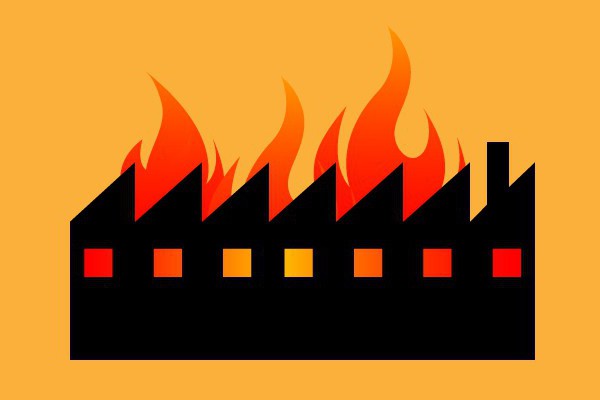How to determine the degree of fire resistance of a building, on what factors does the fire resistance limit depend on? The answers to these questions should be known to any architect or owner. Thanks to this knowledge, it is possible to easily develop a fire escape route, the position of emergency exits, etc. But in our time there are many architectural solutions for the construction of the same type of buildings, so the determination of the fire resistance of each may cause some difficulties.
What is the fire resistance of a building and why is it determined?
Fire resistance design - this is an indicator with which you can find out the degree of resistance of a given design to fire.
Even in the ancient world, people suffered from accidental or intentional arson of wooden and thin-walled buildings. This prompted society to create emergency exits and improve building methods. And people noticed that wooden structures, no matter how strong they are, actively support combustion, and stone, on the contrary, is difficult to burn to ashes. This served as an impetus for the introduction of the concept of fire resistance.
With the help of a practical setting of the fire resistance indicator, the most fire and explosive parts of the building are identified.
Categories of test facilities by content
The presence in the room of explosive or simply flammable substances significantly reduces the level of fire resistance of the structure. So, buildings or rooms are divided into several groups, reflected in the table.

| Category | Characterization of materials and / or substances |
| A (explosion and fire hazard) | In a building or building, there are gallons with flammable gases or flammable liquids, with a combustion temperature of less than 30 ° C.
Materials or other objects that can easily ignite in contact with air, water, surface, with each other. In this case, explosions and fires form the air pressure in the room, exceeding 5 kPa. |
| B
(fire and explosion hazard) |
Explosive gases and liquids with an ignition temperature of more than 30 ° C are present.
Flammable liquids in large quantities, capable of forming toxic fumes and dusty air mixtures, during the outbreak of which the air pressure in the building or room is higher than 5 kPa. |
| AT
(fire hazard) |
The building has flammable or slow-burning liquids and / or materials and solids. Moreover, they are able to easily ignite in contact with oxygen, a foreign liquid or with each other, without causing an explosion, but only burning. |
| G
(potentially dangerous) |
Non-combustible substances and materials are in the building or premises in a heated state or during processing. In this case, heat, light, sparks, etc. can be generated. |
| D
(no danger) |
Only non-combustible liquids and other materials in the building are refrigerated or frozen. |
Hazard classes building fire
To know exactly how to determine the degree of fire resistance of a building, the designs of various construction methods are divided into some categories. In accordance with SNiP 21.01.97 "Tech. fire safety requirements regulation ”, all buildings are divided into several classes K (state of load-bearing structures, walls and stairs) and C (state of the whole building).

What is category K?
1. K0 (fireproof).
The structure is not damaged, there are no flammable materials inside the room (near the supporting structures), the supporting structures themselves are not capable of spontaneous combustion and ignition at medium temperatures (~ 500 ° C).
2. K1 (low fire hazard).
On the supporting structures of the building damage is allowed no more than 40cm horizontally and vertically. There is no burning or thermal effect.
3. K2 (moderately fire hazard).
On load-bearing structures, vertical damage of up to 80 cm and horizontal damage of up to 50 cm are allowed. There is also no thermal effect.
4. K3 (fire hazard).
Damage to load-bearing structures of more than 80 and 50 cm. There may be a thermal effect and combustion.
What is category C?
- С0 - supporting structures, stairwells, utility rooms, etc. correspond to class K0.
- C1 - damage to supporting structures and partitions to K1, external walls to K2, and stairwells and stairs themselves must be in perfect condition.
- C2 - damage to supporting structures and partitions is allowed to K2, external walls to K3, stairs and stairwells to K1.
- C3 - damage to stairwells and stairs to K1, the rest is not considered.
Both indicators are directly related to each other and are necessary to learn how to determine the fire resistance of a building.
Fire resistance levels of buildings
Obviously, to understand how to determine the degree of fire resistance of a building, you need to look at the calculations and practical methods, but all the results obtained during testing should be listed in a table so that you can correlate the indicators and determine if the building meets the design standards.
The Constitution of the Russian Federation considers several levels of fire resistance of buildings. We reflect this in a visual table.

| Fire resistance category | The level of practical fire hazard of the building | Maximum allowable height | Fire compartment area |
| I | C0
C0 C1 |
75 m
50 m 28 m |
2500 m2
2500 m2 2200 m2 |
| II | C0
C0 C1 |
28 m
28 m 15 m |
1800 m2
1800 m2 1800 m2 |
| III | C0
C1 C2 |
5 m
5 m 2 m |
100 m2
800 m2 1200 m2 |
| IV | Not considered | 5 m | 500 m2 |
| V | Not considered | 3; 5 m | 500; 800 m2 |
What is SNiP?
SNiP - Building Norms and Rules - a set of laws established by the legislative and executive authorities of the Russian Federation, regulating the rules for the construction of urban and rural buildings and structures. Also included in this document are architectural design and engineering searches. After a detailed study of it, the owner can easily use the drawings of buildings and determine the state of the structure.
You should always use reference materials to find out the degree of fire resistance of a building. How to determine SNiP for a particular building using reference materials and a construction passport? As a rule, experienced citizens turn to the code of SNiP (01/21/97) - on the fire safety of structures and buildings.
And in order to prepare for testing, it is recommended to study SNiP (03/31/2001), which describes the laws of construction and operation of structures and buildings of the Russian Federation.
Rules for determining the fire resistance of buildings
And now, knowing why the owner needs to know how to determine the degree of fire resistance of a building, we will establish the basic rules during the practical application of the manual.

- During testing, you must have with yourself the architectural plan of the structure, "Rules for ensuring fire resistance and fire safety of reinforced concrete structures", "Manual on determining the limits of fire resistance of structures to SNiP", the Guide to SNiP "Preventing the spread of fire."
- The structural strength limit is expressed in terms of the time a simple fire is exposed to the building under test. When the state of the structure reaches one of the limits, the fire is artificially stopped.
- Before testing, study the building documents: characteristics, materials, fire resistance tests, etc.
- Pay attention to the presence or absence in the documents of a conclusion on the use of special technologies to increase the level of fire resistance.
- During the preliminary study of the building structures, it is necessary to take into account all the utility rooms, stairwells, etc. It is possible that other materials were used for their manufacture, or they are already damaged and their strength is significantly reduced.
- During the construction of modern or large structures, architects often use the latest technological solutions. Often, they may not be as durable as the main part of the structure, which is worth considering.
- Prepare fire extinguishing methods in advance. Hire a fire brigade, check the condition of the cylinders and hoses, and only after full compliance with safety standards start work.
After completing the preparatory phase, you can proceed to practice.
Practical fire detection
Now, it is time to find out the general method by which the degree of fire resistance of buildings and structures is calculated. How to determine this indicator using practical methods, and what devices are needed for this?

Firstly, no matter how thoroughly the architectural plan of the building and reference materials were studied, they must be taken with you.
To conduct the test, install the furnace so that its surface is at a distance of 10 cm from the test part of the building. Using a nozzle, kerosene is sprayed into the oven (as a rule) and set on fire. The temperature in the furnace is regulated using a thermocouple.
Use the table of combustion and melting temperatures of various materials so as not to cause a real fire.
Table of values of melting and burning temperatures
| Wood | 230-260 ° C | Cellular Polycarbonate | 220–240 ° C |
| PVC | ~ 400 ° C | Steel | 1450–1600 ° C |
| Concrete (cement) | ~ 1500 ° C | Gypsum | 900 ° C |
| Red bricks | ~ 1300 ° C | Gypsum concrete | Up to 1450 ° С |
| Refractory bricks | > 1580 ° C | Clay | 1350-1580 ° C |
The essence of fire resistance
An ordinary fire using a furnace affects a certain part of the building until the material reaches its limit: it will light up, soften, etc. Fire resistance is the number of hours or minutes of exposure to a structure by fire at a certain temperature, as well as the speed of fire propagation. For different types of buildings, the time indicator can vary from 0.2 to 2.5 hours, and the ignition rate from 0 to 40 cm per minute. 
This method calculates the degree of fire resistance of a residential building. How to determine after the experiment the exact level of the remaining parameters? To do this, refer to the tables of safety levels of materials of load-bearing structures and levels of structural safety (tables K and C, respectively).
However, in real life, various methods of calculating how to determine the degree of fire resistance of a building can be used. Examples of some public institutions help to better understand the basic structure of a practical method.
Determination of fire resistance of a kindergarten or school
Schools after construction do not begin to function immediately. First, architects and developers must go through a series of mandatory tests of the suitability of the building for people in it, especially primary school and kindergarten children. People are often hired to calculate the degree of fire resistance of a kindergarten building. How to determine it without formulas and estimates, while not damaging the building, is studied separately.

The degree of fire resistance depends on the number of seats in the garden and on the height of the building. One or two storey gardens (50 places; 3 m) must have a III degree of fire resistance and С0 fire hazard.
Buildings with a capacity of more than 100 places and a height of 3 m must have C1 fire safety and III degree of fire resistance of the building. How to determine the number of seats? This indicator depends on the population of the area. According to SNiP, the number of places in a manger is allowed to be increased to 120 per 1000 inhabitants of the district, on average 60-90.
Gardens with a capacity of more than 150 seats must have a II degree of fire resistance and C1 fire safety. At a height of at least 6 m.
Children's institutions with more than 350 children's places and a height of 9 m have II or I resistance level and C0 or C1 safety.
Determination of resilience of a district hospital
It is already known how to determine the degree of fire resistance of a building, if it is a school or kindergarten, and what to do with hospitals? They have their own rules and regulations.
In public buildings of this type, the maximum permissible height is 18 m, while the degree of fire resistance must be I or II, and safety C0.
At a height of up to 10 m, fire resistance decreases to II, and structural safety to C1.

If the height of the building is 5 or less meters, then the degree of fire resistance can be III, IV or V, and the level of structural safety, respectively, C1, C1-C2, C1-C3.
There is nothing more complicated in the study of the topic “Degree of fire resistance of a building”, how to determine the level of safety in a RB (district hospital).
Conclusion
It is not so difficult to actually determine the degree of fire resistance of a building. Difficulties arise only at the practical stage, however, this is less than half and even less than a third of the total work. After studying the architectural plan, the condition of the building as a whole and the condition of the supporting structures, the tester has already done most of the work!
Calculating the fire resistance of structures is more expensive than difficult. The main thing is to observe extreme caution, attentiveness and control the temperature in the furnace during testing.









